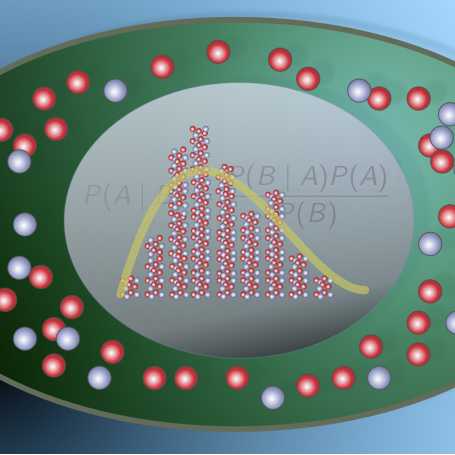How Molecules Can Do Statistics
Researchers of the ETH Zurich have shown how noise filters can be realised using biochemical reactions. This could help improve the reliability of synthetic biological circuits and play an important role in the development of new medical therapies.

Mobile phones have become commonplace. Modern communication devices like mobile phones need to exchange huge amounts of information. However, what is hidden underneath the elegantly shaped plastic casings is quickly forgotten: Complex signal processors constantly fighting against noise and steadily adapting themselves to changing environment.
But noise and changing environmental conditions do not only affect electrical circuits. In synthetic biology scientists are facing similar problems. However, in synthetic biology a methodology to deal with noise does not exist yet. Prof. Mustafa Khammash and Christoph Zechner of the Department of Biosystems Science and Engineering, located in Basel, have studied how conventional signal processors can be translated into biochemical processes – built and operated inside living cells.
A major limitation in engineering biological circuits is that host cells – even if they are genetically identical – are never the same. For instance, cell A might be in a different cell-cycle stage or have more ribosomes available than cell B. Therefore, the same synthetic circuit may behave very differently in each of these two cells. In extreme cases, only a small fraction of cells might show the correct behavior, while the remaining cells act unpredictably. This is referred to as context-dependency.
A key strategy for achieving noise-resistant and hence context-independent behavior is to build a circuit that evaluates what the noise looks like, allowing it to be separated from the signal effectively. Noise-cancelling earphones, for instance, heavily rely on this idea: A little microphone measures the background signals. A statistical algorithm predicts how the background signals propagate to the inside of the earphone. Finally, this predicted signal cancels out with the background signal. Apparently, the same principle can be applied to suppress noise in biological circuits. In particular, a circuit can behave context-independently if it can cancel out the effect of its molecular environment with the help of a noise filter.
Such filters have been intensively studied during the rise of telecommunications in the 1950s. The success of the filtering ideas culminated in the invention of the Kalman filter (named after Prof. em. Rudolf Kalman at ETH Zurich), which has had a revolutionary impact on various fields – ranging from telecommunications to financial engineering. Today there exists hardly any discipline of engineering that is not touched directly by the Kalman filter.
Unfortunately, the Kalman filter does not directly apply to molecular systems because its underlying mathematical assumptions are incompatible with molecular biology. Thus, a statistical noise filter called the Poisson filter has been invented, realizable through a single gene that has both a constitutive and an inducible promoter. As Christoph Zechner explains further: “We found out that under certain meaningful assumptions, a surprisingly simple noise filter can be derived – the Poisson filter. The name stems from the fact that it is based on a certain probability distribution named after the French mathematician Siméon Poisson.” The researchers tested the Poisson filter by using a genetic circuit in bacterial cells that can be induced by green light. They applied arbitrary noise signals to the circuit, which was indeed able to track the light-signals at a remarkable precision. Consequently, the Poisson filter can be understood as a molecular analog of the Kalman filter.
Mustafa Khammash points out that they have collaborated with Georg Seelig at the University of Washington in Seattle on one of the experimental parts of the project. “George Seelig is an expert in DNA-based synthetic circuits. Some of the in vitro experiments were carried out in his lab, while others were done here in Basel.”
Circuits like the above could play an important role for synthetic biology to reach many of its potential applications such as new therapeutics or biosensing. For example, ETH researchers have recently proposed a selective medical drug that can distinguish healthy from tumor cells using a synthetic circuit that is transfected into the cells (more information in ETH Life). If a cell is found healthy, it is left unaffected by the circuit. In case a cancer cell is detected, a medical compound is released that induces apoptosis, i.e. programmed cell death. Unfortunately, cell-to-cell variability may severely impact the performance of the circuit such that misclassifications are likely. As a consequence, the drug’s intended effect may be inverted in a fraction of the cells, meaning that healthy cells are killed, while cancer cells can proliferate unaffectedly.
Filtering circuits provide a promising strategy to address this issue. More specifically, they could be used to effectively suppress cell-to-cell variations and in turn improve the specificity and efficacy of a drug. “The goal of our project was to design context-independent synthetic circuits. The next important step is to test our framework in practical applications”, Christoph Zechner sums up. And as Mustafa Khammash concludes: “The molecular filters we have invented can be utilized for estimating cellular states. Such estimates would enable noise-resistant biosensors and feedback regulation, among other applications.”
Reference
Zechner C et al. Molecular Circuits for Dynamic Noise Filtering. Proceedings of the National Academy of Sciences 2016. doi: external page 10.1073/pnas.1517109113